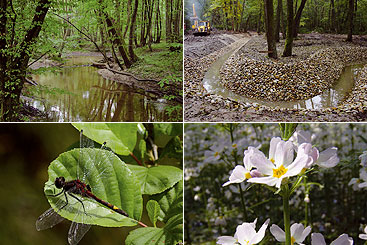
Restoring the wetlands of the Záhorie Lowlands
A new project funded by the EU’s LIFENature programme is helping to improve habitat conditions for some of the most threatened plant and animal species in the Záhorie region.

The Rudava River, which flows across the area, is one of the best preserved tributaries of the March River. The wetlands provide a habitat for rare dragonflies, such as Ophiogomphus cecilia, and many rare plant species, including the Water Violet (Hottonia palustris).
The Záhorie lowlands represents the largest area of windswept sand dunes sands in slovakia. This area, located in south-western slovakia has an outstanding diversity of biotopes. The acidic sand provides a substrate for Pannonic inland dune habitats, while wetland habitats are found in the depressions between the dunes. The Rudava River, which flows across the area, is one of the best preserved tributaries of the March River.
The vast intensification of agriculture in the past century, especially in its second half, didn’t spare this area. Almost all the important wetland sites were drained. This resulted in a decline of wetland biotopes as well as many of their typical species. Today there is a trend to restore these valuable and species-rich habitats. Luckily, wetlands typically have a dynamic character and much of their function can be restored in a relatively short time if their water regime is returned to original conditions.
Community importance, community support. The State Nature Conservancy of the Slovak Republic, Regional Association for Nature Conservation and Sustainable Development (BROZ) and the Slovak Water Management Enterprise are working together to improve natural conditions in this area. The work is being undertaken within the project “Restoration of the Wetlands of Záhorie Lowland”, funded by the LIFE-Nature programme of the European Union. The main aim of the project is to contribute to the creation of Natura 2000 network sites in the Záhorie region. The project area includes eight sites of Community Importance, seventeen Habitats of Community Interest and six Habitats of National Interest.
“A lot of the work is done by volunteers – this gives us a chance to promote nature conservation in this region and to show people the values and functions of wetland areas,” says Dr. Jaromír Šíbl, the project manager.
ZahoRIE lowlaNd
Project title: Restoration of the Wetlands of
Zahorie Lowland
Start date/end date: 01/02/2005 to 31/12/2008
Project beneficiary:
State Nature Conservancy of
Slovak Republic
Project partners:
Slovak Water Management
Enterprise, Department Bratislava
BROZ — Regional Association for Nature Conservation
and Sustainable Development
Total project budget: €624,000
EU financial contribution: €312,000 (50%)
Financial contribution of beneficiary and
Partners:
€312,000 (50%)
Protecting outstanding diversity. The wetlands are a home to many rare plant species, including a tiny orchid Fen Orchid (Liparis loeselii), glacial relicts Cotton Deer Grass (Trichophorum alpinum), Meadow Bistort (Polygonum bistorta), Bog Arum (Calla palustris), and Common Sundew (Drosera rotundifolia). Swamp alder woods, which are the most valuable forest communities in the area, also depend on adeqautely high levels of groundwater and seasonal floods. Elongated Sedge (Carex elongata) is a typical plant species in these forests, but rare species like Marsh Fern (Thelypteris palustris), Bogbean (Menyanthes trifoliata) and Water Violet (Hottonia palustris) can be found here as well. The wetlands also provide a habitat for rare species of dragonflies Leucorrhinia pectoralis, Ophiogomphus cecilia and Cordulegaster heros. The streams are teeming with 39 species of fish and 18 species of amphibians and reptiles.

Wetlands have a dynamic character and much of their function can be restored relatively quickly if their water regime is returned to original conditions. Fortunately, the swamp alder woods in the region have responded well after restoration. The Záhorie Lowland streams are home to 39 species of fish and 18 species of reptiles and amphibians, such as this edible frog (Rana esculenta).
The revitalisation work is focused on restoration of the wetlands water regime and improvement of habitat conditions for the most threatened plant and animal species. Another goal is to construct a fish by-pass at the Rudava River to restore this important fish migration route, and to restore the species-rich lowland meadows along the rivers’ floodplain.
“I am really happy that I could work on these sites,” says project volunteer Pavol Littera. “Sometimes I return there, just to see how they are changing into a natural state. It gives me a good feeling that I helped to make these places nicer.”
For more information visit, please visit: www.broz.sk
Disclaimer
The information contained in the ICPDR website is intended to enhance public access to information about the ICPDR and the Danube River. The information is correct to the best of the knowledge of the ICPDR Secretariat. If errors are brought to our attention we will try to correct them.
The ICPDR, expert group members, nor other parties involved in preparation of information contained on this website cannot, however, be held responsible for the correctness and validity of the data and information provided, nor accept responsibility or liability for damages or losses arising directly or indirectly from the use of the information conveyed therein.
Only those documents clearly marked ICPDR documents reflect the position of the ICPDR.
Any links to other websites are provided for your convenience only. The ICPDR does not accept any responsibility for the accuracy, availability, or appropriateness to the user's purposes, of any information or services on any other website.
When using the information and material provided on this website, credit should be given to the ICPDR.
